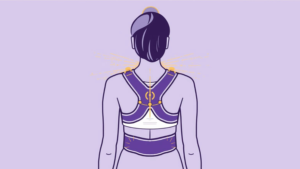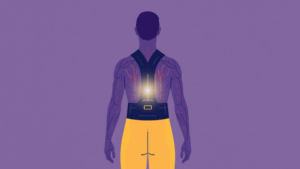Back pain has emerged as one of the most prevalent musculoskeletal issues worldwide, affecting millions of people across age groups, professions, and lifestyles. According to the Global Burden of Disease study, lower back pain is a leading cause of disability, impacting daily functioning, productivity, and overall quality of life. The causes are multifactorial, ranging from sedentary lifestyles, prolonged sitting, poor posture, muscle imbalances, and occupational strain to injuries, degenerative spinal conditions, and post-surgical recovery. While medical treatments, physiotherapy, and exercise remain primary interventions, many people seek additional support to manage pain and improve mobility.
Among the various supportive aids available, back pain belts have gained significant attention. These devices are designed to stabilize the spine, support muscles, reduce strain, and promote proper posture [1]. Their effectiveness lies in combining biomechanical principles with ergonomic design, which allows users to maintain activity while minimizing the risk of further injury. By providing external support to the lumbar and thoracic regions, back pain belts can decrease the load on paraspinal muscles, improve proprioception, and, in some cases, enhance recovery following surgery or injury.
A properly chosen back pain belt does more than just provide temporary relief. Scientific studies indicate that lumbar belts can reduce intervertebral disc pressure, improve spinal alignment, and enhance core stability during activity. They are particularly useful for people involved in manual labor, weightlifting, or jobs requiring prolonged standing or bending, where repetitive spinal stress can lead to chronic pain or acute injuries. Additionally, belts designed for posture correction help counteract the negative effects of sedentary work and poor ergonomic setups by promoting proper spinal alignment and muscle engagement.
The modern market offers a wide variety of belts tailored for specific needs, such as compression belts for inflammation reduction, heat therapy belts for muscle relaxation, magnetic belts for alternative pain management, and specialized belts for pregnancy or post-surgery recovery. With this diversity, it can be overwhelming to select the right product, especially when considering factors like material quality, adjustability, comfort, and therapeutic features. Furthermore, choosing a belt with evidence-based benefits ensures that the investment contributes to real, measurable improvement rather than being a temporary or cosmetic solution.
In India, back pain belts have gained popularity not only in clinical settings but also among fitness enthusiasts, office workers, and individuals recovering from surgery or injury. Leading brands now offer belts that combine ergonomic design with scientifically validated features, ensuring a balance between comfort, durability, and functionality. One such emerging brand is Betterhood, known for its high-quality lumbar support and posture correction belts, which are designed with breathable materials and adjustable features to cater to varied body types and usage scenarios.
This article aims to provide a comprehensive guide on back pain belts, covering their types, scientific rationale, benefits, and how to choose the right product. By understanding the biomechanics, therapeutic principles, and practical considerations behind each belt type, readers can make informed decisions to enhance spinal health, manage pain effectively, and improve overall quality of life. Whether you are dealing with chronic back pain, recovering from surgery, or seeking preventive support, this guide will help you navigate the options available in the Indian market and identify belts that offer both comfort and clinically relevant support.
Want to dive deeper? Here are a few related reads you’ll enjoy:
- https://betterhood.in/learn/effective-home-remedies-for-body-pain-relief-naturall/
- https://betterhood.in/learn/impact-of-surface-hardness-on-tailbone-pain-cushion-vs-no-cushion/
What is a Back Pain Belt? Definition and Purpose
A back pain belt is a wearable supportive device designed to stabilize the spine, reduce stress on muscles and ligaments, and improve posture. They are commonly used in:
- Lower back pain management
- Post-surgical recovery
- Muscle strain prevention during heavy lifting
- Pregnancy-related back support
Scientific Basis: Back pain belts function by providing external support to the lumbar and thoracic spine. Biomechanically, they reduce the load on paraspinal muscles, distribute weight evenly, and limit excessive spinal flexion or extension. Studies suggest that lumbar belts can decrease intervertebral disc pressure and enhance core stability during activity, which can help reduce pain and prevent further injury.
Types of Back Pain Belts
Back pain belts are designed to address specific needs. Understanding their types helps users choose the most effective solution.
Lumbar Support Belts
Purpose: These belts target the lower back (lumbar region) to provide stability and compression. They are especially helpful for people with chronic lower back pain or those performing manual labor.
Scientific Insight: Lumbar support belts work by increasing intra-abdominal pressure, which unloads the spine and reduces strain on spinal muscles and ligaments. Research shows that proper lumbar support can reduce fatigue during prolonged standing or lifting activities.
Use Case: Factory workers, warehouse staff, or gym-goers performing heavy lifting.
Posture Correction Belts
Purpose: Posture corrector belts aim to align the spine properly, preventing slouching and reducing postural strain.
Scientific Insight: Poor posture leads to muscle imbalances and chronic stress on spinal ligaments, often resulting in pain. Posture belts provide biofeedback, reminding users to maintain proper spinal alignment [2]. With time, consistent use can strengthen postural muscles.
Use Case:
- Office workers, students, or anyone spending long hours sitting.
Compression Back Belts
Purpose: These belts provide targeted compression to reduce inflammation, support muscles, and improve proprioception.
Scientific Insight: Compression improves blood flow, reduces swelling, and enhances muscle coordination. Athletes often use compression belts to prevent injury and accelerate recovery.
Use Case:
- Post-workout recovery, mild injury management, or chronic strain support.
Heat Therapy Belts
Purpose: Heat therapy belts incorporate warmth-generating elements to relax muscles, improve circulation, and reduce stiffness.
Scientific Insight: Heat application promotes vasodilation, increasing oxygen and nutrient delivery to tissues. This aids muscle recovery and reduces pain associated with stiffness. Heat belts are particularly effective for chronic muscle tightness or arthritis-related back pain.
Use Case:
- Elderly individuals with stiffness, office workers, or post-exercise recovery.
Magnetic Therapy Belts
Purpose: Magnetic belts claim to reduce pain by influencing blood flow and nerve activity through magnetic fields.
Scientific Insight: Evidence on magnetic therapy is mixed. Some studies report minor pain relief, but most experts consider it a complementary aid rather than a primary treatment.
Use Case:
- Users seeking alternative therapies for mild chronic pain.
Adjustable Back Pain Belts
Purpose: Adjustable belts allow customized fit and compression, which improves comfort and effectiveness.
Scientific Insight: A well-fitted belt ensures even pressure distribution, preventing muscle strain and avoiding circulation restriction. Adjustable straps also accommodate different body shapes and sizes.
Use Case:
- Anyone needing personalized support, especially during variable activity levels.
Post-Surgery Support Belts
Purpose: Designed for post-operative recovery, these belts stabilize the surgical site, reduce pain, and support proper posture.
Scientific Insight: Post-surgery belts limit excessive movement, which protects healing tissues. They also reduce stress on incision areas and abdominal muscles, promoting faster recovery.
Use Case:
- Patients recovering from spinal, abdominal, or hernia surgeries.
Pregnancy Back Pain Belts
Purpose: These belts relieve lumbar and pelvic strain during pregnancy.
Scientific Insight: Pregnancy shifts the center of gravity and increases lumbar lordosis, putting strain on the lower back [3]. Support belts lift the belly slightly, redistribute weight, and reduce muscle fatigue.
Use Case:
- Pregnant women experiencing lower back or pelvic pain.
Benefits of Back Pain Belts
- Pain Relief: By stabilizing the spine and muscles, belts reduce strain and discomfort.
- Posture Improvement: Encourages proper spinal alignment and muscle activation.
- Muscle Support: Reduces fatigue during repetitive or heavy tasks.
- Injury Prevention: Limits excessive spinal movements, protecting ligaments and discs.
- Enhanced Recovery: Post-surgical and post-injury belts aid healing by restricting harmful motions.
- Convenience: Lightweight, portable, and easy to wear during daily activities.
Scientific Evidence Supporting Back Pain Belts
Several studies highlight the effectiveness of back pain belts:
- Lumbar Belts: Reduce compressive forces on intervertebral discs by 10–30%, relieving strain on muscles.
- Compression & Posture Belts: Improve proprioception, reducing the risk of acute injury.
- Heat Therapy: Proven to reduce muscle stiffness and improve circulation in chronic back pain patients.
Important Note: Belts should complement, not replace, core strengthening exercises, physiotherapy, or medical treatment. Prolonged use without exercise may lead to muscle weakening.
How to Choose the Right Back Pain Belt
When selecting a belt, consider:
- Type of Pain/Need: Lumbar support, posture correction, post-surgery, or pregnancy support.
- Material: Breathable fabrics prevent sweating and skin irritation.
- Adjustability: Straps and sizes for custom fit.
- Comfort: Lightweight and non-restrictive.
- Therapeutic Features: Heat, magnets, or compression depending on your requirement.
- Reviews & Reliability: Check user reviews and clinical recommendations.
Reviews and Buying Guide
Here’s a snapshot of popular belts available in India:
| Type | Popular Brands | Key Feature |
| Lumbar Support | DonJoy, Tynor, betterhood | Adjustable lumbar straps for targeted support |
| Posture Corrector | BeFit, Dr. Ortho, betterhood | Shoulder and back alignment, lightweight design |
| Compression | Oppo, Vissco, betterhood | Elastic compression panels for muscle support |
| Heat Therapy | Dr. Physio, and CareQuip | Electric or chemical heat pads for muscle relaxation |
| Pregnancy | Mothercare, and Tynor | Belly lift and lumbar support for pregnancy-related back pain |
Tips for choosing the right belt:
- Check material and breathability to prevent sweating and irritation.
- Ensure adjustable straps for a comfortable and secure fit.
- Look for therapeutic features (heat, compression, posture correction) depending on your need.
- Consider betterhood belts for a combination of ergonomic design and affordability, as they are designed with real user feedback and clinical recommendations in mind.
- Read user reviews and seek professional advice if using post-surgery or for chronic conditions [5].
Safety Tips and Precautions
- Consult a doctor or physiotherapist before starting belt use.
- Avoid wearing belts for more than 4–6 hours continuously.
- Combine belt use with core strengthening exercises.
- Keep belts clean and dry to prevent skin irritation.
- Avoid over-tightening; this may restrict blood flow.
Conclusion
Back pain belts are no longer just temporary relief tools, they are integral components of modern spinal care. With increasing awareness about posture, ergonomics, and musculoskeletal health, individuals are turning to scientifically designed belts that provide targeted support, reduce strain, and promote recovery [6]. Whether it’s a lumbar support belt for workers lifting heavy loads, a posture corrector for office professionals, or a post-surgery belt aiding recovery, these devices serve as practical aids in daily life.
Scientific studies consistently highlight the benefits of back pain belts, such as reducing intervertebral disc pressure, enhancing core stability, and promoting proper spinal alignment. Belts with compression or heat therapy further support muscle relaxation and improved circulation, accelerating recovery from injuries or chronic strain. For pregnant women, specialized belts redistribute weight and reduce lumbar stress, demonstrating the adaptability of these devices across varied health scenarios.
In conclusion, back pain belts provide a scientifically validated, practical, and accessible way to manage back discomfort, enhance posture, and support recovery. With proper selection and usage, they can significantly improve daily comfort, physical performance, and overall quality of life. By understanding the types, benefits, and appropriate use of back pain belts, individuals can make informed decisions and invest in products that truly enhance spinal health. Brands like Betterhood, with their ergonomic and user-friendly designs, offer reliable options for anyone seeking effective support. Ultimately, integrating back pain belts with lifestyle adjustments and preventive care ensures long-term spinal well-being, allowing you to stay active, comfortable, and healthy.
Looking for more tips? Don’t miss these related guides.
Frequently Asked Questions:
1. Which back pain belt is best for Indian climate?
The best belt for Indian conditions should be lightweight, breathable, and adjustable. Look for mesh or cotton-blend fabrics with moisture-wicking properties to prevent sweating and rashes. Belts with smooth, skin-friendly linings and Velcro adjustability work best in hot and humid weather.
2. Can I wear it while exercising?
Yes, you can wear a back belt while exercising, especially during heavy lifting, bending, or twisting movements. It improves spinal stability and reduces strain. However, don’t over-rely on it, prolonged use may weaken core muscles. Use it only when needed and maintain proper form during workouts.
3. How often should I replace my back belt?
A back belt should generally be replaced every 12–18 months if used daily, or every 2 years if worn occasionally. Replace it sooner if:
- The elastic loosens or stitching frays
- Velcro stops gripping
- Support feels weaker
- Fabric causes irritation
4. Are back belts safe for elderly users?
Yes, elderly users can safely wear back belts if chosen carefully. They provide support for conditions like arthritis, osteoporosis, and spinal degeneration. But seniors should use belts that are gentle, cushioned, and easy to wear, as tight or stiff belts may affect circulation or cause skin irritation. Medical advice is recommended.
5. Can pregnant women use a back support belt?
Yes, but only pregnancy-specific support belts should be used. These are soft, breathable, and designed to support the belly while reducing lumbar strain. They should never be too tight or restrictive. Pregnant women should consult their doctor before use, and avoid wearing the belt during sleep.
References
- Cholewicki, J., Juluru, K., Radebold, A., Panjabi, M. M., & McGill, S. M. (1999). Lumbar spine stability can be augmented with an abdominal belt and/or increased intra-abdominal pressure. European Spine Journal, 8(5), 388–395. https://doi.org/10.1007/s005860050193
- McGill, S. M. (1997). The biomechanics of low back injury: Implications on current practice in industry and the clinic. Journal of Biomechanics, 30(5), 465–475. https://doi.org/10.1016/S0021-9290(96)00172-8
- Wong, A. Y. L., Parent, E. C., Funabashi, M., Kawchuk, G. N., Prasad, N., & Fortin, M. (2017). Do back support belts reduce back pain, functional disability, or work absenteeism? A systematic review. American Journal of Industrial Medicine, 60(6), 525–538. https://doi.org/10.1002/ajim.22721
- Serola Biomechanics. (2022). Pregnancy support belt: How it works and benefits. Retrieved from https://www.serola.net (for pregnancy-specific support belts, consumer info with clinical application).
- Bai, J., et al. (2023). Effects of non-extensible lumbar belts on static and dynamic postural stability in healthy male participants. BMC Musculoskeletal Disorders, 24, 556. https://doi.org/10.1186/s12891-023-06476-w























